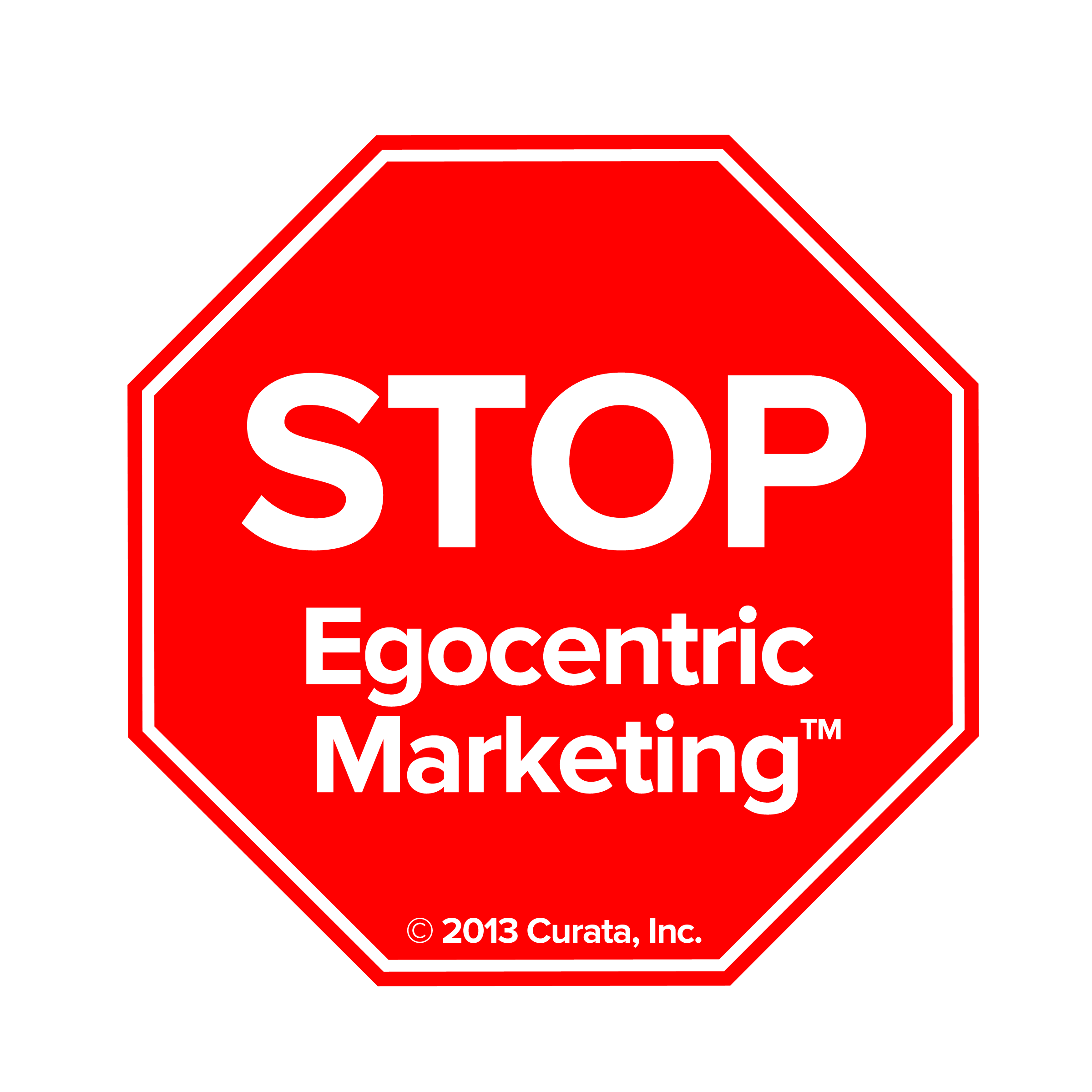- Share STOP Egocentric Content Marketing on Facebook
- Share STOP Egocentric Content Marketing on Twitter
- Share STOP Egocentric Content Marketing on Linkedin
- Share STOP Egocentric Content Marketing via email
 The good news is that most marketers have adopted content marketing as a key part of their marketing strategy. 87% to be exact according to Curata’s most recent content marketing research. No longer are we telling buyers about our own products. We are now providing our own insight and guidance about the topics that are of greatest interest to them. We have evolved…or have we? Most marketers continue to communicate to their audience in their voice only, striving to be the sole source of content on their chosen topic. Only the best-in-class marketers have begun to understand that we must stop egocentric content marketing, and complement our own created content with the wealth of knowledge that the rest of the market has to offer. For our own benefit, as well as that of our audience.
The good news is that most marketers have adopted content marketing as a key part of their marketing strategy. 87% to be exact according to Curata’s most recent content marketing research. No longer are we telling buyers about our own products. We are now providing our own insight and guidance about the topics that are of greatest interest to them. We have evolved…or have we? Most marketers continue to communicate to their audience in their voice only, striving to be the sole source of content on their chosen topic. Only the best-in-class marketers have begun to understand that we must stop egocentric content marketing, and complement our own created content with the wealth of knowledge that the rest of the market has to offer. For our own benefit, as well as that of our audience.
The Good News…
Marketers have made significant progress since the days of “product out” marketing. Most of us today are well on-board the content marketing “wave”. The main driver enabling this progress is the fact that at no other time in history have so many people had the power of being their own author and publisher as today. We have a plethora of content types to chose from and even more options to channel that content to our customers:
- Content Types: eBooks, whitepapers, presentations, case studies, infographics, articles, blog posts, Tweets, comments, etc.
- Content Channels: Web sites, blogs, digital publications, email, newsletters, LinkedIn, Twitter, YouTube, Google+, Disqus, etc. (e.g., there are over 42M blogs in the US alone, and over 500,000 daily new posts)
Even better, there is a ready market to absorb this content, for example:
- 329M people viewing at least one blog per month in the US
- 500M+ Twitter users
- 230M+ LinkedIn users
- 10M+ SlideShare users
Over half of marketers intend to increase their spend on content marketing in the next 12 months to support this movement! (CMI and MarketingProfs joint study) Marketers are on a steady path to becoming publishing houses targeted specifically at their customers needs.
Key steps being taken by leading marketers to create their own content include:
- Assigning direct accountability for their company’s content marketing strategy
- Hiring dedicated content development staff
- Crowdsourcing content from within their own organization
- Outsourcing content development
- Licensing content
- Tapping into user-generated content
However, as good as all of these options are for your content marketing strategy, content creation alone is not enough. There are two main problems that must be overcome to advance to the next level of content marketing maturity:
- Internal Challenge: Very few marketing organizations have the financial or human resources to provide a regular stream of high quality, relevant original content for their customers; and
- External Challenge: As great as a vendor’s content may be, customers want to be exposed to varying opinions and perspectives. If you don’t provide it to them, they will go elsewhere.
The Opportunity to Differentiate Your Content Marketing Strategy
Most marketers continue to communicate to their audience in their voice only, striving to be the sole source of content on their chosen topic. Not that their content isn’t of high quality or even highly relevant to their audience; but customers simply prefer to absorb information from many disparate sources which provide a diverse set of perspectives and opinions. Not to mention that information originating solely from a vendor will always be perceived as having some level of bias. Best-in-class marketers have begun to understand that we must stop egocentric content marketing, and complement our own created content with the wealth of knowledge that the rest of the market has to offer. Content curation offers this opportunity.
The definition of content curation is as follows:
“Content curation is the process of an individual (or team) consistently finding, curating and sharing the most relevant and highest quality digital content on a specific topic for their target market.” [Curata]
As marketers, whether we realize it or not, most of us have been curating content for quite sometime now. Examples include: Tweets that provide short commentary and a link to an article of interest to your readers; a blog post where you quoted a couple of comments from other experts on a specific topic and then offered your own insight and guidance; or an infographic where you gathered data from multiple sources, with attribution, to provide value for your readers. However, only the most advanced content marketers are fully leveraging curation to improve their inbound marketing strategy, and with great success.
Benefits of complementing your created, original content with curated content include:
- Thought Leadership and brand awareness: Marketers will be able to provide their own insight and guidance in the context of other industry research and perspectives, thereby demonstrating that their own messaging is in-line with the context of other market leaders.
- Traffic and Leads: Producing more, high quality content on a regular basis will increase the size and frequency of readership. This will lead to an increase in engagement with your target market as part of a comprehensive lead nurturing process.
- Cost and Time Savings: Marketing organizations do not need to rely solely on their own resources for content creation to fulfill the needs of their content marketing strategy; and
- Direct Customer Benefit: Customers will have the opportunity to learn the perspectives and opinions of the best that the Internet has to offer in one place.
Download the full ebook to learn more on how to STOP egocentric marketing.







